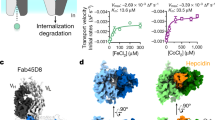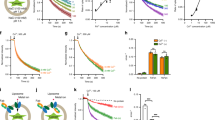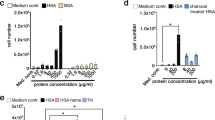Abstract
HFE is related to major histocompatibility complex (MHC) class I proteins and is mutated in the iron-overload disease hereditary haemochromatosis. HFE binds to the transferrin receptor (TfR), a receptor by which cells acquire iron-loaded transferrin. The 2.8 Å crystal structure of a complex between the extracellular portions of HFE and TfR shows two HFE molecules which grasp each side of a twofold symmetric TfR dimer. On a cell membrane containing both proteins, HFE would ‘lie down’ parallel to the membrane, such that the HFE helices that delineate the counterpart of the MHC peptide-binding groove make extensive contacts with helices in the TfR dimerization domain. The structures of TfR alone and complexed with HFE differ in their domain arrangement and dimer interfaces, providing a mechanism for communicating binding events between TfR chains. The HFE–TfR complex suggests a binding site for transferrin on TfR and sheds light upon the function of HFE in regulating iron homeostasis.
This is a preview of subscription content, access via your institution
Access options
Subscribe to this journal
Receive 51 print issues and online access
$199.00 per year
only $3.90 per issue
Buy this article
- Purchase on Springer Link
- Instant access to full article PDF
Prices may be subject to local taxes which are calculated during checkout




Similar content being viewed by others
References
Andrews,N. C. & Levy,J. E. Iron is hot: An update on the pathophysiology of hemochromatosis. Blood 92, 1845–1851 (1998).
Bacon,B. R. et al. Molecular medicine and hemochromatosis: at the crossroads. Gastroenterology 116, 193–207 (1999).
Feder,J. N. et al. A novel MHC class I-like gene is mutated in patients with hereditary hemochromatosis. Nature Genet. 13, 399–408 (1996).
Garcia,K. C., Teyton,L. & Wilson,I. A. Structural basis of T cell recognition. Annu. Rev. Immunol. 17, 369–397 (1999).
Lebrón,J. A. et al. Crystal structure of the hemochromatosis protein HFE and characterization of its interaction with transferrin receptor. Cell 95, 111–123 (1998).
Feder,J. N. et al. The hemochromatosis founder mutation in HLA-H disrupts β2-microglobulin interaction and cell surface expression. J. Biol. Chem. 272, 14025–14028 (1997).
Waheed,A. et al. Hereditary hemochromatosis: effects of C282Y and H63D mutations on association with β2-microglobulin, intracellular processing, and cell surface expression of the HFE protein in COS-7 cells. Proc. Natl Acad. Sci. USA 94, 12384–12389 (1997).
Feder,J. N. et al. The hemochromatosis gene product complexes with the transferrin receptor and lowers its affinity for ligand binding. Proc. Natl Acad. Sci. USA 95, 1472–1477 (1998).
Parkkila,S. et al. Association of the transferrin receptor in human placenta with HFE, the protein defective in hereditary hemochromatosis. Proc. Natl Acad. Sci. USA 94, 13198–13202 (1997).
Aisen,P., Wessling-Resnick,M. & Leibold,E. A. Iron metabolism. Curr. Opin. Chem. Biol. 3, 200–206 (1999).
Richardson,D. R. & Ponka,P. The molecular mechanisms of the metabolism and transport of iron in normal and neoplastic cells. Biochim. Biophys. Acta 1331, 1–40 (1997).
Lebrón,J. A. & Bjorkman,P. J. The transferrin receptor binding site on HFE, the Class I MHC-related protein mutated in hereditary hemochromatosis. J. Mol. Biol. 289, 1109–1118 (1999).
Lebrón,J. A., West,A. P. & Bjorkman,P. J. The hemochromatosis protein HFE competes with transferrin for binding to the transferrin receptor. J. Mol. Biol. 294, 239–245 (1999).
Gross,C. N., Irrinki,A., Feder,J. N. & Enns,C. A. Co-trafficking of HFE, a nonclassical major histocompatibility complex class I protein, with the transferrin receptor implies a role in intracellular iron regulation. J. Biol. Chem. 273, 22068–22074 (1998).
Lawrence,C. M. et al. Structure of the ectodomain of human transferrin receptor. Science 286, 779–782 (1999).
Fuchs,H. et al. Structural model of phospholipid-reconstituted human transferrin receptor derived by electron microscopy. Structure 6, 1235–1243 (1998).
Creighton,T. E. Proteins: Structures and Molecular Properties (W. H. Freeman and Co., New York, 1993).
Jones,S. & Thornton,J. M. Principles of protein–protein interactions. Proc. Natl Acad. Sci. USA 93, 13–20 (1996).
Wolf,E., Kim,P. S. & Berger,B. MultiCoil: A program for predicting two- and three-stranded coiled coils. Protein Sci. 6, 1179–1189 (1997).
Fujinaga,M. et al. Refined crystal structure of the seryl-tRNA synthetase from Thermus thermophilus at 2.5 Angstroms resolution. J. Mol. Biol. 234, 222–233 (1993).
Barton,J. C., Sawada-Hirai,R., Rothenberg,B. E. & Acton,R. T. Two novel missense mutations of the HFE gene (I105T and G93R) and identification of the S65C mutation in Alabama hemochromatosis probands. Blood Cells, Molecules, and Diseases 25, 147–155 (1999).
Egan,T. J., Zak,O. & Aisen,P. The anion requirement for iron release from transferrin is preserved in the receptor–transferrin complex. Biochemistry 32, 8162–8167 (1993).
Turkewitz,A. P., Schwartz,A. L. & Harrison,S. C. A pH-dependent reversible conformational transition of the human transferrin receptor leads to self-association. J. Biol. Chem. 263, 16309–16315 (1988).
Bali,P. K., Zak,O. & Aisen,P. A new role for the transferrin receptor in the release of iron from transferrin. Biochemistry 30, 324–328 (1991).
Bairoch,A. & Apweiler,R. The Swiss-Prot protein sequence data bank and its supplement TrEMBL in 1999. Nucleic Acids Res. 27, 49–54 (1999).
Sipe,D. M. & Murphy,R. F. Binding to cellular receptor results in increased iron release from transferrin at mildly acidic pH. J. Biol. Chem. 266, 8002–8007 (1991).
Buchegger,F. et al. Functional analysis of human/chicken transferrin receptor chimeras indicates that the carboxy-terminal region is important for ligand binding. Eur. J. Biochem. 235, 9–17 (1996).
Dubljevic,V., Sali,A. & Goding,J. W. A conserved RGD (Arg-Gly-Asp) motif in the transferrin receptor is required for binding to transferrin. Biochem. J. 341, 11–14 (1999).
Anderson,B. F. et al. Structure of human lactoferrin: crystallographic structure analysis and refinement at 2.8 Å resolution. J. Mol. Biol. 209, 711–734 (1989).
Enns,C. A. & Sussman,H. H. Physical characterization of the transferrin receptor in human placentae. J. Biol. Chem. 256, 9820–9823 (1981).
Henry,J. B. Clinical Diagnosis and Management by Laboratory Methods (W. B. Saunders Co., Philadelphia, 1991).
Roy,C. N., Penny,D. M., Feder,J. N. & Enns,C. A. The hereditary hemochromatosis protein HFE specifically regulates Tf-mediated iron uptake in HeLa cells. J. Biol. Chem. 274, 9022–9028 (1999).
Parkkila,S. et al. Immunohistochemistry of HLA-H, the protein defective in patients with hereditary hemochromatosis, reveals unique pattern of expression in gastrointestinal tract. Proc. Natl Acad. Sci. USA 94, 2534–2539 (1997).
Waheed,A. et al. Association of HFE protein with transferrin receptor in crypt enterocytes of human duodenum. Proc. Natl Acad. Sci. USA 96, 1579–1584 (1999).
Wilson,I. A. & Bjorkman,P. J. Unusual MHC-like molecules: CD1, Fc receptor, the hemochromatosis gene product, and viral homologs. Curr. Opin. Immunol. 10, 67–73 (1998).
Verland,S. et al. Specific molecular interaction between the insulin receptor and a D product of MHC class I. J. Immunol. 143, 945–951 (1989).
Stagsted,J. et al. Regulation of insulin receptor functions by a peptide derived from a major histocompatibility complex class I antigen. Cell 62, 297–307 (1990).
Otwinowski,Z. & Minor,W. Processing of X-ray diffraction data collected in oscillation mode. Methods Enzymol. 276, 307–326 (1997).
De La Fortelle,E. & Bricogne,G. Maximum-likelihood heavy-atom parameter refinement for multiple isomorphous replacement and multiwavelength anomalous diffraction methods. Methods Enzymol. 276, 472–494 (1997).
Kleywegt,G. J. & Jones,T. A. Template convolution to enhance or detect structural features in macromolecular electron density maps. Acta Crystallogr. D 53, 179–185 (1997).
Collaborative Computational Project No. 4. The CCP4 suite: programs for protein crystallography. Acta Crystallogr. D 50, 760–763 (1994).
Brünger,A. T. et al. Crystallography and NMR system: A new software system for macromolecular structure determination. Acta Crystallogr. D 54, 905–921 (1998).
Kraulis,P. MOLSCRIPT: a program to produce both detailed and schematic plots of protein structures. J. Appl. Crystallogr. 24, 946–950 (1991).
Merritt,E. A. & Murphy,M. E. P. Raster3D Version 2.0-a program for photorealistic molecular graphics. Acta Crystallogr. D 50, 869–873 (1994).
Evans,S. V. SETOR: hardware lighted three-dimensional solid model representations of macromolecules. J. Mol. Graphics 4, 134–138 (1993).
Kawabata,H. et al. Molecular cloning of transferrin receptor 2. J. Biol. Chem. 274, 20826–20832 (1999).
Nicholls,A., Bharadwaj,R. & Honig,B. GRASP—graphical representation and analysis of surface properties. Biophys. J. 64, A166 (1993).
Acknowledgements
We thank C. M. Lawrence and S. C. Harrison for sharing structural information and coordinates before publication; Z. A. Hamburger for assistance with synchrotron data collection; A. Cohen and M. Soltis for synchrotron support; P. M. Snow and I. Nangiana for expression of TfR; S. Jones for assistance with interface analyses; and A. J. Chirino, C. Enns and J. N. Feder for helpful discussions. M.J.B. was supported by a Cancer Research Institute Postdoctoral fellowship.
Author information
Authors and Affiliations
Corresponding author
Rights and permissions
About this article
Cite this article
Bennett, M., Lebrón, J. & Bjorkman, P. Crystal structure of the hereditary haemochromatosis protein HFE complexed with transferrin receptor. Nature 403, 46–53 (2000). https://doi.org/10.1038/47417
Received:
Accepted:
Issue Date:
DOI: https://doi.org/10.1038/47417
This article is cited by
-
Host receptor-targeted therapeutic approach to counter pathogenic New World mammarenavirus infections
Nature Communications (2022)
-
Rational design of universal immunotherapy for TfR1-tropic arenaviruses
Nature Communications (2020)
-
The role of HFE genotype in macrophage phenotype
Journal of Neuroinflammation (2018)
-
Types and effects of protein variations
Human Genetics (2015)
-
Alterations in expression profile of iron-related genes in colorectal cancer
Molecular Biology Reports (2013)
Comments
By submitting a comment you agree to abide by our Terms and Community Guidelines. If you find something abusive or that does not comply with our terms or guidelines please flag it as inappropriate.



